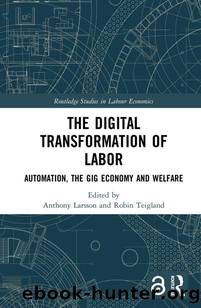The Digital Transformation of Labor; Automation, the Gig Economy and Welfare by Unknown

Author:Unknown
Language: eng
Format: epub
Publisher: Routledge
Published: 2019-11-09T00:00:00+00:00
2. Discussion
2.1. The cause of âgig patientsâ
For many workers, the âgig economyâ offers an irresistible allure where they are free to set their own schedule. Likewise, whenever entrepreneurs need to enlist help, or as their entrepreneurial company grows, the âgig economyâ offers a way out of the expense of having payroll insurance, employee benefits, sick leave and vacations. Thus, entrepreneurs only need to pay for the work they need, whenever it is needed. Since the advent of digital technology along with information and communications technology (ICT) devices, an increasing number of workers and entrepreneurs alike have begun to identify themselves as âdigital nomadsâ (Sisson, 2017). This means that they no longer depend on work in traditional workplaces, but are free to work anywhere and whenever, as long as there is access to a laptop computer or a tablet computer and an adequate internet connection (Müller, 2016). Conversely, it is also possible to gain many different short-term workplaces via the âgig economyâ. That is to say, the âgig economyâ offers a wide array of freelance jobs available on the online market for various professions and skillsets.
Unshackled from the constraints placed by managers and corporate norms, workers can choose the assignments they feel put their talents to the greatest use while choosing only the assignments that they find appealing. The workers thus have a sense of agency in what they produce and how to manage their own life situation. However, while the personal freedom is far-reaching, the stakes are also exceptionally high and the cost may be far more than a financial one.
The workers are invariably expected to always produce and deliver and to always be on top of their game (Petriglieri, Ashford and Wrzesniewski, 2018). Keeping oneâs level of productivity at top capacity at all times is a constant struggle, and invariably means working long hours (Sinicki, 2018). Distress and distractions can erode oneâs level of productivity, as can various forms of obstacles that may appear along the way. Of course, various forms of health-related issue also act as impediments, which risks creating a vicious circle where the worker is less productive due to stress and/or illness, but yet has to compensate by putting in more hours to make up for lost productivity, which consequently serves to worsen the stress and/or illness (OâConnor, 2018).
As previously mentioned, one of the greatest boons for those contracting labor is not having to pay for various forms of welfare benefits. On the flipside, this is also one of the greatest banes to the workers. That is to say, the âgig economyâ rarely or never offer workers any benefits of any kind that is commonly found among the traditional social safety net, such as sick pay, parental leave, paid vacations, paid course training, etc. Thus, âgiggersâ lack the possibility to take paid leave and receive such low wages that they are unable to take time off and fund their own health care. The aforementioned tendency of âgiggersâ lacking traditional health insurance serves to further deepen the problem.
Download
This site does not store any files on its server. We only index and link to content provided by other sites. Please contact the content providers to delete copyright contents if any and email us, we'll remove relevant links or contents immediately.
Bad Blood by John Carreyrou(6558)
Rich Dad Poor Dad by Robert T. Kiyosaki(6414)
Principles: Life and Work by Ray Dalio(6226)
Playing to Win_ How Strategy Really Works by A.G. Lafley & Roger L. Martin(5937)
Management Strategies for the Cloud Revolution: How Cloud Computing Is Transforming Business and Why You Can't Afford to Be Left Behind by Charles Babcock(4528)
The Confidence Code by Katty Kay(4190)
Thinking in Bets by Annie Duke(4154)
American Kingpin by Nick Bilton(3760)
Delivering Happiness by Tony Hsieh(3369)
Project Animal Farm: An Accidental Journey into the Secret World of Farming and the Truth About Our Food by Sonia Faruqi(3178)
The Power of Habit by Charles Duhigg(3063)
The Tyranny of Metrics by Jerry Z. Muller(3005)
Brotopia by Emily Chang(3002)
Mastering Bitcoin: Programming the Open Blockchain by Andreas M. Antonopoulos(2983)
The Marketing Plan Handbook: Develop Big-Picture Marketing Plans for Pennies on the Dollar by Robert W. Bly(2978)
I Live in the Future & Here's How It Works by Nick Bilton(2938)
The Content Trap by Bharat Anand(2863)
Building a StoryBrand by Donald Miller(2843)
Applied Empathy by Michael Ventura(2839)
